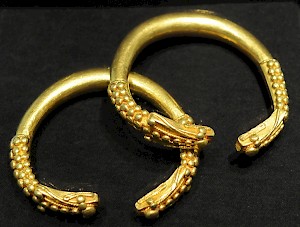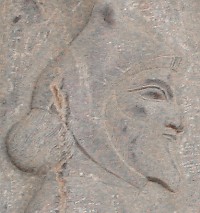Herodotus, bk 5, logos 13
Herodotus of Halicarnassus (c.480-c.429 BCE): Greek researcher, often called the world's first historian. In The Histories, he describes the expansion of the Achaemenid Empire under its kings Cyrus the Great, Cambyses, and Darius I the Great, culminating in Xerxes' expedition to Greece (480 BCE), which met with disaster in the naval engagement at Salamis and the battles at Plataea and Mycale. Herodotus' book also contains ethnographic descriptions of the peoples that the Persians have conquered, fairy tales, gossip, and legends.
Persian conquest of Thrace (5.1-28)

The fifth book of Herodotus' Histories marks the beginning of the wars between the Persians and the Greeks. After a short digression on Thracian customs, Herodotus tells us about Megabazus' conquest of Thrace and the ensuing submission of eastern Macedonia. One of the newly conquered towns is Myrcinus, which the Persian king Darius presents to Histiaeus of Miletus as a reward for his role in the retreat of the Persian army from Scythia (above). This loyal Greek becomes one of Darius' advisors in Persia - according to Herodotus a kind of honorable detention.
Megabazus' successor as governor of the European territories is Darius' son-in-law Otanes, who subdues several Greek towns between the Aegean Sea and the Black Sea (a.o. Byzantium), together with the islands Lemnos and Imbros. Herodotus praises this governor with the words that the troubles between Persians and Greeks ceased for a while.
Comment

Thrace is commonly taken as modern Bulgaria, together with the European part of Turkey and the northeast of Greece. Perhaps, the Persian possessions were larger, because there is a modern report about the discovery of an Old Persian inscription at Gherla in Romania, known as DG, although the possibility cannot be ruled out that the inscription was brought to Romania from its original site.
Otanes' policy was a sound one. By conquering the towns between the Aegean Sea and the Black Sea, the road from Asia to Europe was safe. The conquest of Lemnos and Imbros was the logical sequel: these islands guarded the entrance of the Hellespont.
Myrcinus was famous for its timber and its silver mines. Its significance is that Miletus obtained the means to build a large navy, comparable to that of Polycrates of Samos, who had ruled the waves before, and Athens, which was to do the same in the fifth century (see below). From now on, no one doubted that Miletus was the leading city among the Ionian Greeks. Soon, the great king had reason to regret his royal gift.